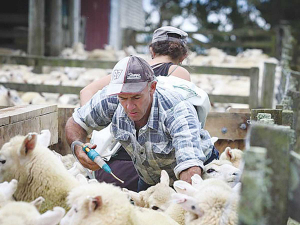Move over ham, here comes lamb
It’s official, lamb will take centre stage on Kiwi Christmas tables this year.
 With new lambs on the ground farmers are being urged to make an internal parasite management plan for the coming season.
With new lambs on the ground farmers are being urged to make an internal parasite management plan for the coming season.
As this season’s lamb crop hits the ground, farmers are being urged to make an internal parasite management plan for the coming season.
Dannevirke-based vet and Wormwise national spokesperson Simon Marshall, says if farmers are considering drenching ewes at docking, they should carry out out Faecal Egg Counts (FECs) on a sample of ewes first.
The results of the FECs, in combination with body condition scores and pasture cover assessments, will help determine whether ewes need a drench at that time. But lambs are the focus in spring and farmers should be working with their vet or animal health provider now to put together a drench plan for this season.
This means deciding what drench to use and if using drench leftover from last season, whether it is still within the expiry date and has been stored correctly. Drench guns should be checked and correctly calibrated. At every drenching, a sample of animals should always be weighed to ensure stock are being given the correct dose.
Marshall says the decision about which drench family or families to use should be based on a FEC reduction test carried out in conjunction with a vet, in summer or autumn.
This test shows which drench families are effective and highlights any drench resistance issues.
“Plan to do one this coming season and talk to your vet about getting a test done. It needs to be planned well in advance.”
Marshall says some farmers carry out a pre-weaning lamb drench as a matter of course, while others give lambs their first drench at weaning. This depends on the weaning dates, but many farmers are weaning earlier, so should discuss their options with their vet or advisor.
After weaning, it is important farmers stick to the 28-30-day drenching routine and look at using refugia. This means planning how they are going to achieve it, ensuring everyone on the farm team knows how it works and how it is being implemented.
FECs taken seven to 10 days after the first or second lamb drench – from lambs known to have been drenched correctly – will show the efficacy of the drench being used. A parasite cycle is around 21 days, so a test at 25 days will indicate a worm problem.
“If you don’t need to drench when lambs are on these crops, then carry out FECs to monitor the lambs’ worm status and inform drench decisions.”
He adds that the most effective parasite management strategy is either finishing lambs quickly or selling lambs as stores.
“Lambs are the best multipliers of parasites so when the lambs are off the farm, they are not multiplying parasites and they are out of the system.”
Going into autumn, FECs carried out well before mating will indicate whether two-tooth and mixed-age ewes need a drench before the ram goes out.
Article sourced from Beef+Lamb NZ
Virtual fencing and herding systems supplier, Halter is welcoming a decision by the Victorian Government to allow farmers in the state to use the technology.
DairyNZ’s latest Econ Tracker update shows most farms will still finish the season in a positive position, although the gap has narrowed compared with early season expectations.
New Zealand’s national lamb crop for the 2025–26 season is estimated at 19.66 million head, a lift of one percent (or 188,000 more lambs) on last season, according to Beef + Lamb New Zealand’s (B+LNZ) latest Lamb Crop report.
Farmers appear to be cautiously welcoming the Government’s plan to reform local government, according to Ag First chief executive, James Allen.
The Fonterra divestment capital return should provide “a tailwind to GDP growth” next year, according to a new ANZ NZ report, but it’s not “manna from heaven” for the economy.
Fonterra's Eltham site in Taranaki is stepping up its global impact with an upgrade to its processed cheese production lines, boosting capacity to meet growing international demand.

OPINION: Your old mate welcomes the proposed changes to local government but notes it drew responses that ranged from the reasonable…
OPINION: A press release from the oxygen thieves running the hot air symposium on climate change, known as COP30, grabbed your…